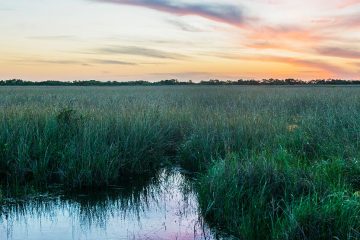Tram Tour Provides a Guided Glimpse of the Flora, Fauna and Precarious State of South Florida’s Disappearing Everglades
I’d fantasized about visiting Everglades National Park in South Florida since the 1960s, when I first watched Lincoln Vail, an Everglades wildlife officer, chase bad guys in his high-speed airboat as it buzzed across the gator-infested swamp.
When my husband, Jimmy, suggested a day trip from Miami’s South Beach during a recent stay, I clapped my hands in delight and headed off to obtain directions from the concierge.
Jimmy drove toward The Everglades’ Shark Valley entrance via Tamiami Trail, a creepy highway we agreed would not be a good place to break down. But once we pulled into the park, paid the entrance fee and chatted with the ranger, we felt at ease.
That is, until I almost tripped on an alligator.
We bought tickets for a two-hour guided tram ride of North America’s largest wetlands that runs along a 15-mile causeway through Shark Valley. While waiting for the tour, I noticed a photographer outfitted with a 400mm lens snapping away at snoozing alligators and wading egrets.
I trailed him to the edge of the drainage canal and came toe-to-tail with a surprisingly black, not green, gator. Although he appeared docile, I sensed his powerful jaws could crunch my leg in less time than it takes to say “cheese.” Slowly, I turned…
Our witty naturalist guide, Tony Arjoonsingh, calmed my fears, explaining that crocodiles, which prefer salt water, consider people a delicacy but alligators, which prefer fresh water, slither away in fear. Shark Valley contained fresh water; hence, alligators but no crocodiles (and no sharks).
He recalled only one incident of an Alligator attacking a visitor. “A young boy got too close to a baby gator for its mother’s comfort,” Tony said. “The boy’s own mother jumped into the canal and started beating on and hollering at the alligator until it released him.”
We learned the Everglades is a unique eco-system, North America’s only subtropical preserve and the world’s largest continuous saw grass prairie, a shallow “river of grass” marching from the headwaters of Lake Okeechobee, south toward Florida Bay. Unfortunately, less than 50 per cent remains.
Mislabeled a useless swamp, the Glades were first coveted in the 1840s by land developers who attempted to drain what was actually a slow moving, 120-mile long river.
Unsuccessful at first, chants to pull the plug resumed in 1905 when Napoleon Bonaparte Broward campaigned for governor on a platform to “drain that abominable, pestilence-ridden swamp.” Broward and his successors built thousands of miles of canals and levees that channeled fresh water away from the Everglades and toward the Gulf of Mexico and the Atlantic.
South Floridians, though, discovered the freshwater of the Everglades served an important purpose: it kept salt water out of the underlying aquifer’s coastal wells. As the ocean dribbled out of residents’ taps, cities raced to dam canals and push freshwater tables back above sea level. But, the ecological damage had been done.
European family vacations are a great opportunity to give your kids a cultural experience they'll never forget. Here's where you should go.
Unless some semblance of natural water flow is restored, the Everglades, its diverse wildlife and south Florida’s drinking water supply will go the way of the dinosaur.
Halfway through the tour, we disembarked from the tram and climbed a 65-foot observation tower, offering sweeping views of the primordial prairie and elevated hardwood hammocks punctuating the otherwise sea level landscape.
These jungled islands contained clumps of mahogany, gumbo-limbo, cocoplum, oak, red maple and hackberry trees and provided dry refuge for flora and fauna and, at one time, the Miccosukee Indians.
Back on the tram, Tony pointed out the exotic birds swooping around us: blue herons, white egrets, ibises, black vultures and snail kites.
At the end of the tour, we ambled up the causeway toward Bobcat Boardwalk and Otter Cave Hammock Trail. Alligator after alligator tail saluted our stroll. Still slightly gator-phobic, I tiptoed over to a sun-worshipping reptile and studied its prehistoric face.
It seemed unfazed by the hordes of humans walking and biking through its backyard.
“Julie, can you snuggle up to the gator so I can squeeze both of you into the photo?” Jimmy asked. I obliged, but glanced over my shoulder for signs of the creature’s 80 pearly whites.
Up at Otter Cave, we wandered under the low-canopied hardwood hammock. My eyes searched the shadows for endangered Florida panthers, but none emerged. Doubling back, we detoured onto Bobcat Boardwalk, crossing a porous limestone bridge with holes large enough to sprain the ankle of anyone not watching their step. The boardwalk meandered through a saw grass marsh shimmering with translucent water and deposited us at the far end of the parking lot where we’d left our rental car.
If our flight had not been the next day, we would have returned to Everglades National Park and spent more time hanging out with the birds and the gators. After all, it’s not that often that I get to fulfill one of my childhood fantasies. I just hope this ecological wonder and its amazing creatures are around the next time I visit the tip of Florida.
Author
Julianne Nardone
